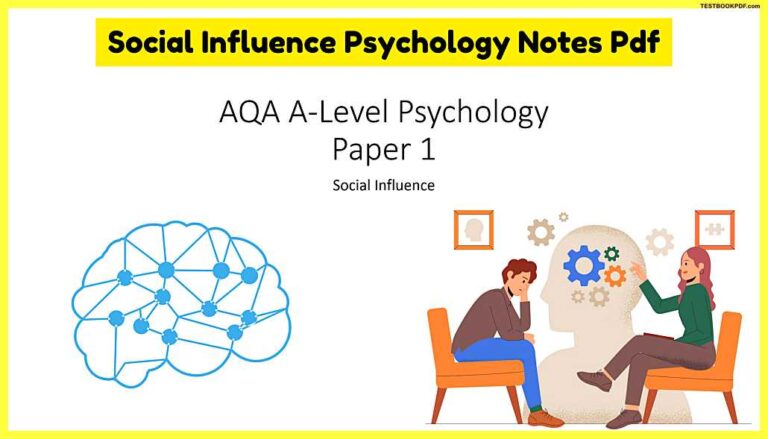Social Influence Psychology Notes Pdf
This article will be focusing on social influence with Social Influence Psychology Notes Pdf Download Button just go to the end of this article So let’s Start.
Types of Conformity
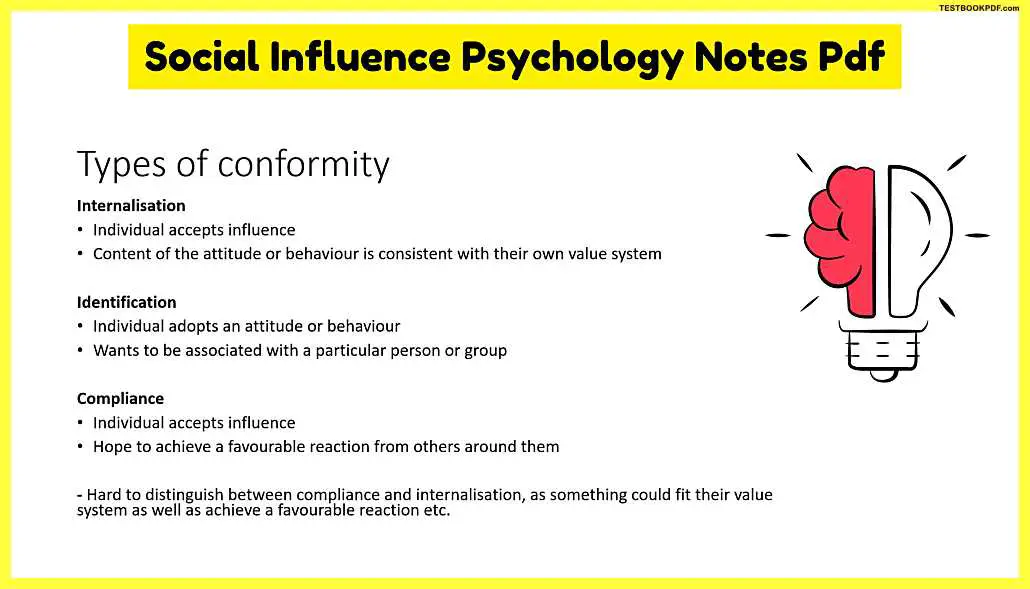
So, firstly types of Conformity are just very like the main basic bit of the social inference topic, so you’ve got three types of conformity –
- Internalization
- Identification
- Compliance
Internalization – which is when an individual accepts influence because the content of the Asch behavior improves them influencing them is consistent with their own value system.
Identification – which is when an individual adopts an attitude or behavior because they are really big not because it fits in with their very system but because they want to be associated with a particular person or group and then you’ve got compliance which is fairly similar to internalization but it’s when no individual it sets influence in the hope to achieve a favorable favorable reaction from others around them.
Compliance – now as I just mentioned it is slightly harder to distinguish between compliance and internalization as something could fit someone’s value system as well as achieve a favorable reaction from those around them so it’s fairly difficult to tell them apart in real-life situations.
Explanations of Conformity
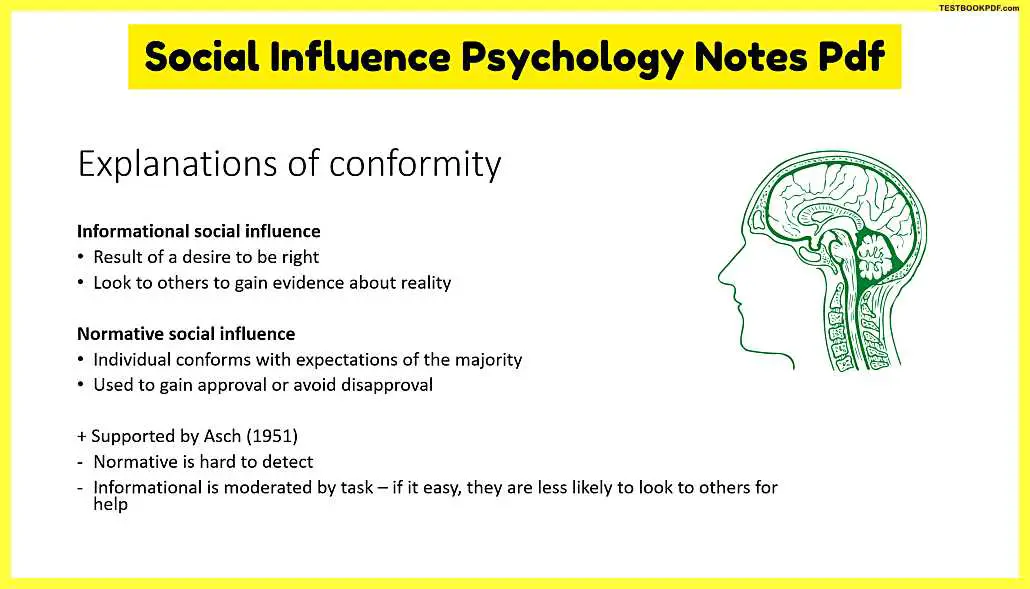
So next we have explanations of conformity that sucker has informational and normative.
Informational social influence – the informational is obvious I think naturally as human beings we have the desire to be bright and as a result, of this informational social influence, we look to others to gain evidence about reality even if it’s not necessarily what we actually think will be with the right answer.
For example – when the teacher in the classroom might say oh! who thinks it’s true who thinks this statement is true all I know, especially I did you’d always sort of look around and see who else was putting their hand up in things which is very much
Normative social influences – this is whereas normative social influences when an individual performs the expected majority usually to gain their approval or avoid disapproval when in a similar situation to what I just explained you don’t you would put your hand up like everybody else because you don’t want to avoid the disapproval from a teacher and you don’t want to sort of making a fool of yourself in the classroom and these ideas are supported by Asch.
Asch’s study in 1951 which we will talk about in a second but normative is a very hard text because it’s such a sort of hidden idea I mean it’s quite obvious when people sort of turn their heads to look to see what other people are doing and where they’re our eyes are doing things but normative like it’s quite difficult to tell whether someone actually thinks that life thinks the same as everybody else or it is actually just because everyone else put their hand up and then informational is obviously moderated by TAS or if it’s an easy task and the person knows that their answer is right they’re not going to look to others whereas obviously as the task gets harder they’ll be more like to look to others for support in their answer to ensure they don’t mess up.
Asch 1951
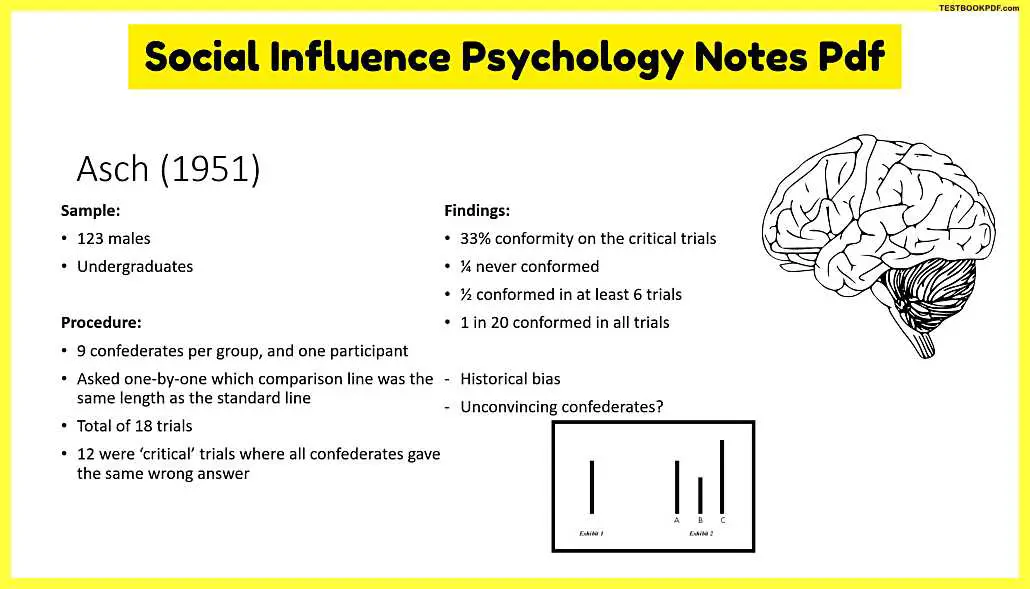
So moving on to Asch’s study so the sample was over 123 males who were all undergraduate students, so straight off it’s a very limited sample I think that I believe the key to that is sample buyers I may be wrong but Straight off the light you can tell slightly not great study just purely for the fact that it’s mainly can it consist of males all of a similar age group and then times the procedure.
So there were nine Confederates prayer groups and if you don’t know it Confederates are sort of fake participants there they are told what to do and say by the researcher and then each group just had one participant they’re one of the hundred men three males and then each group was asked one by one, so it would go from like left to right asking everyone and the part the participant would be the last one to be asked they each person was asked one by one which comparison line was the same length of the standard line and I’ve got sort of a similar one like what was used in the corner there in the picture and there was a total of eighteen trials twelve which were critical trials where all Confederates gave the same wrong answer.
For example, all of the twelve would say that B was the same as that line B and looking at the picture is the same as the individual one on the left-hand side but then of the other six, they would all give the right answer.
And then in terms of findings, 33% were confirmed on the critical trials a quarter never conformed and half of them conformed on at least six trials one in twenty can four informed on all trials.
in terms of historical bias obviously, it was done in nineteen fifty-one side and obviously, I would say in modern society nowadays we tend to focus more on our own opinions like we don’t we won’t always listen to those around us so can it really be applied to a modern society and then obviously if the Confederates weren’t actually very convincing with their answers this may affect the conformity level as well because if you don’t believe the person on the right-hand side of you actually believes in their answer then it may sway your judgment
Variables Affecting Conformity
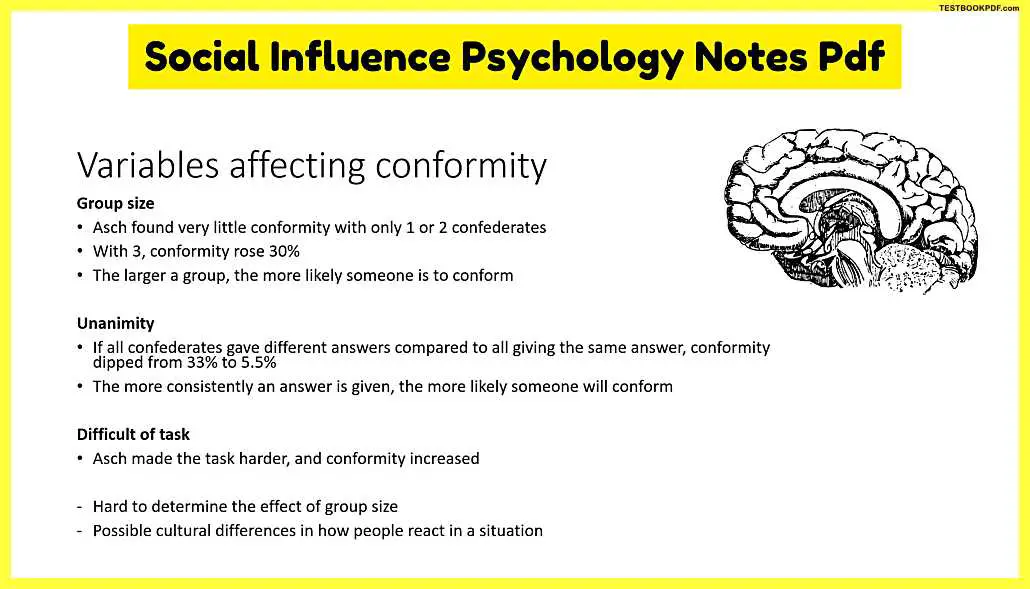
So in terms of variables affecting conformity you’ve got group size these findings are all based on Asch’s research because I believe either in this same study or in one heap in one he did and another time.
Group size – he found the intent the group size there was very little conformity with only one or two Confederates but when it rose to three conformity also raised to third rose by thirty percent which suggests that a lot the larger group the more I saw one is to conform.
Unanimity – in terms of unanimity in anonymity if all the Confederates gave different answers compared to all giving the same answer conformity went from 33% which is when everyone gay gave the same answer to five point five seven everyone gave different answers.
The difficulty of the task – so essentially the more consistent answer is given the more likely someone will conform and then basically in terms of the difficulty of the task.
Like I said earlier in the article if the task is harder and people are more like to conform as they require that need to be right like everyone else and then obviously harvester man the effect of group size because obviously, it could rise with three but then could go down with four again or go down with five.
So that makes sense and they’re obviously possible cultural differences and possible cultural biases because obviously, people from other countries may react a different way depending on their values and how and they’re like social upbringing.
Zimbardo 1973
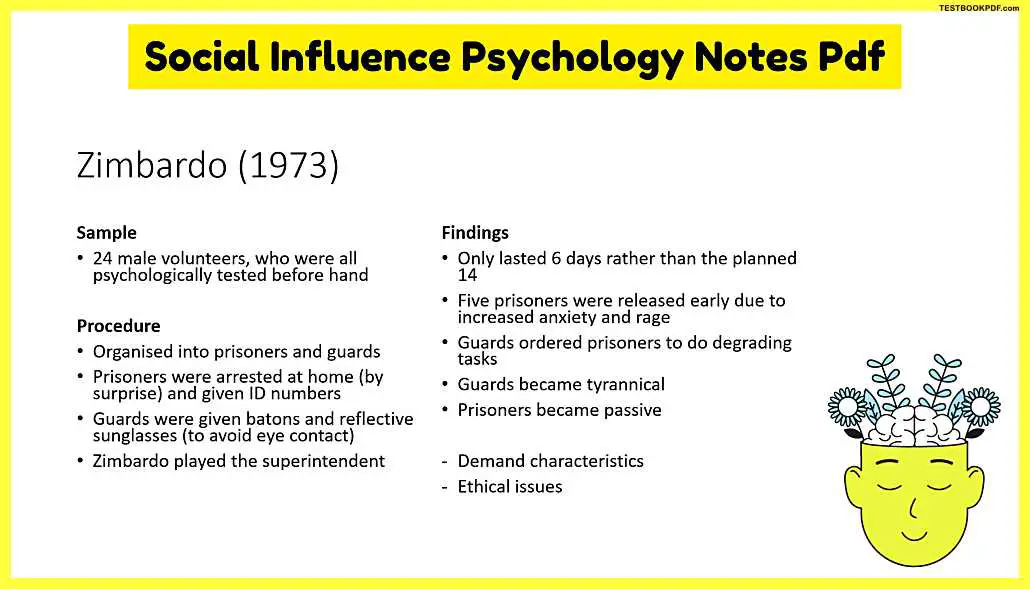
Looking at Zimbardo’s study now which I know is a very very popular one a very well-known study that’s sure.
Sample – in terms of the sample there were 24 male volunteers here who were all psychologically tested beforehand to ensure they were saying and they had and none of them had they were all chosen specifically because they had no mental health issues previously and tells the procedure.
Procedure – it was organized in this these 24 males were organized into prisoner and guards I’m not off the top of my head can I remember what what sort of split they were doing done in but I think it would have been around I think it would have been out 14 prisoners to six guards possibly around that sort of mark the prisoners were arrested but at home by surprise which automatically sets off alarm bells about ethical issues because obviously they wouldn’t have given an informed consent to this and then they were given ID numbers which depersonalized them and similar to that the guards were given batons and reflective sunglasses and the sunglasses were designed to avoid eye contact with the prisoners and then Zimbardo played the superintendent which is quite dangerous role in the research as well because he might he got too invested and it ends up having to be his girlfriend broke up the experiment his Ambala just couldn’t see how damaging it was for the participants and then looking at the findings.
Findings – it actually only lasted six days rather than the planned 14 days and five of the prisoners were released early due to increased anxiety and rage that they face whilst they were inside the prison which I will like says well it took place in I think it was either Yale Harvard like basement it was definitely an American University basement I think it was IDL or Harvard the guards ordered prisoners do degrade tasks such as righteous or clean the toilets and I know from watching a clip I like video on YouTube that um that these were sort of woken up in the middle night and gotten to do tasks and things and obviously that God as the guard came more tyrannical the prisoners became more passive to what was being done to them bossy demonic characters in terms like guards and prisoners are very heavily stereotyped characters.
so to speak for lack of a better word really so people may have assumed that that’s how they’re supposed to behave especially the guards I think they were because they are used to seeing God as being the violent people they would have more I’d been taken on that persona because that’s how they knew the personality to be there also the ethical issues like this was study is where a squishy sort of came from but there wasn’t anything until this study took place and then the companies well associations such as the British British Psychological psychology Society I think it is realized hang on a second that this can’t take place in the future like we can’t this can’t happen again hence why ethical issues all came into play after the study.
Explanations for Obedience
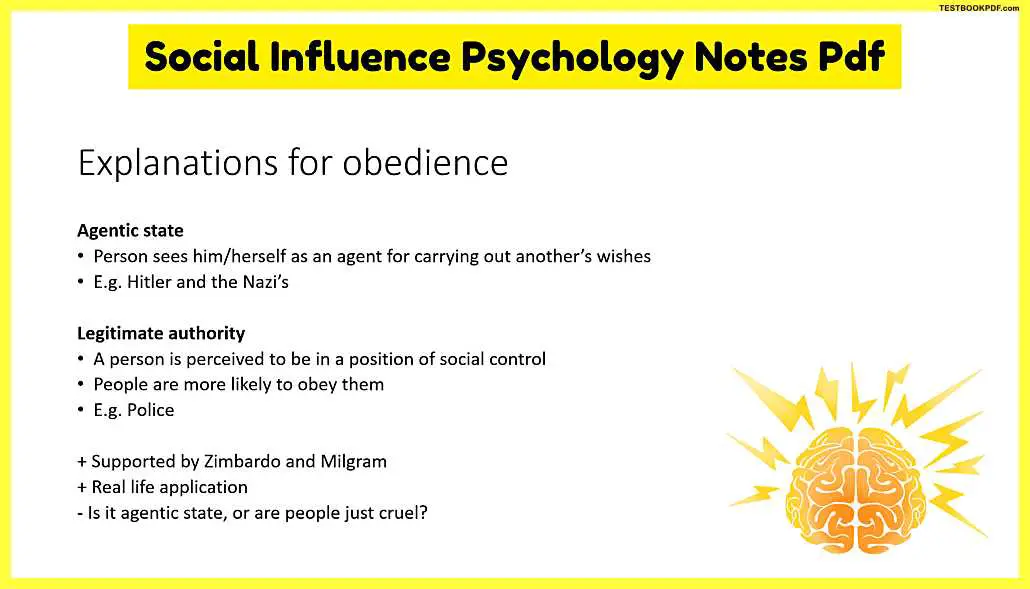
Agentic state – In terms of the agentic state this is when a person sees him or herself as an agent for carrying out others’ wishes such as Hitler and the Nazis I know in recent years when Nazis have been put on trial for their crimes many of them use the explanation we were just asked to do it like it wasn’t us doing it we were like it wasn’t my choice I was just doing what I was told to do and then in terms of legitimate Authority.
Legitimate Authority – if a person is perceived to be in a position of social control people are more likely to obey them so obviously if you see a policeman around your neck you’re gonna be less likely to go and commit a crime more so there and then obviously these ideas are supported by Zimbardo with his with them the prisoners eventually obeying the police the guards in there then obviously Milgram study which gonna look at in a second and then obviously it has got real-life application because you can see things like this in real life and then you’ve got the magenta cape like is the identic state an actual thing or people just cruel when using it as an excuse for their behavior which is something that’s really really tricky to sort explain and actually prove.
Milgram study in 1963
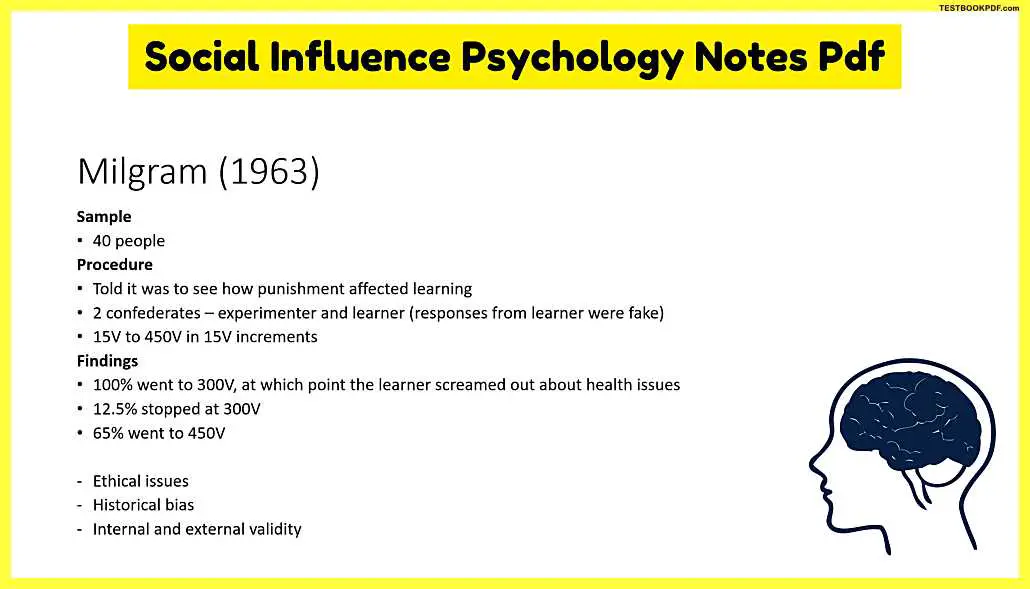
So he did an electric shock study with a sample of 40 people who I believe are all males Milgram told them that it was to see how punishment effective learning.
so immediately this is saying like issues with informed consent when it had two Confederates so an experimenter and a learner and to ensure there was consistency between each participant the responses from the learner were fake and recorded for previously to ensure that each participant receives the same received the same study and then I’ll see the electric shocks that workers that were supposedly given went from 15 volts to 450 volts in 15-volt increments so the person was sawed off with 15 volts if they got the question wrong and move up to third 30 volts and then if they got it right got the question wrong again it would move up to 45 volts etc.
Findings – and then it turns the findings 100% went to 300 volts at which point the learner screamed out about having health issues and I believe these were heart issues more specifically but then obviously 12.5% stuck at 300 volts and 65% amazing you went to 450 volts within the study meaning the rest of them stopped between 300 volts and 450 volts and then you’ve got the ethical issues with this study which I’ve already pointed out with the informed consent and then obviously the mental damage that leads to possibly due to a participant and historical bias with this reality would you get some of the results if this study was repeated in 2019 and then I want you guys to tell me about the internal and external validity issues with this study so comment down below what you think I really want to solve in these videos try and get you thinking more for yourselves and coming up with ideas because then I think that’s how you’ll really learn.
Situational Variables Affecting Obedience

proximity – you’ve got proximity so the teacher and learner are in the same room the obedience fell from there is a spelling mistake I’m sorry about that but the obedience fell from 65% to 40%.
Location – in terms of location if the study was moved from a lab at Yale University to a rundown office building obedient decreased by 40% and I believe these first two were again similar to what Asch did I believe this is Milgram’s work again but changing the variables
Uniform- in terms of uniform bushmen got a theme of dressing up in three costumes and obedience was 72% for a policewoman 48% for a business executive and 52% for a beggar which I know some of you might find a bit weird but personally I think it’s mainly because a beggar may seem but be more stereotypically vicious compared to a business it’s active.
Disposition or Explanations for Obedience
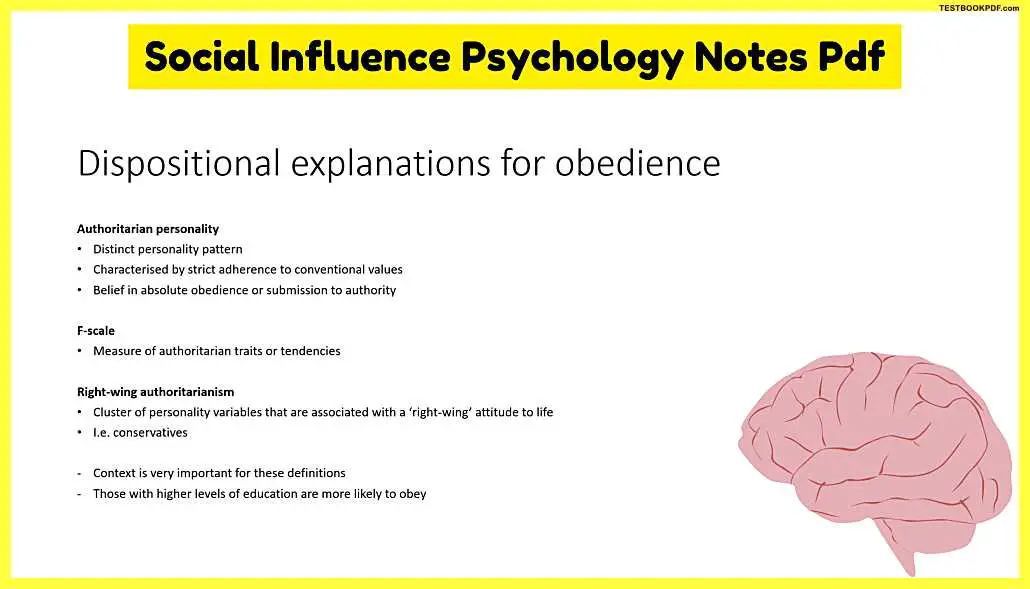
Authoritarian Personality – in terms of all Authoritarian Personality, so this is a distinct personality pattern that is characterized by strict adherence to conventional values and the individual will have a strong belief in absolute obedience or submission to Authority so this is simply just by what we this is similar to sort of the idea of like what we see as like the teacher’s pet like as an example so the student is like so that student is extremely obedient to the teacher who they see as an author Authority figure.
F scale – and then the F scale which we’re going to talk about in a minute it’s a measure of Authoritarian traits or tendencies.
Right-wing Authoritarian – right-wing Authoritarian is basically similar to the Authoritarian and personality but is a cluster of personality variables that are associated with the right-wing assets life and essentially this says you can serve disappointed view so liberals etc however with these definitions context is very very important because they write a quite vague and obviously those with high low levels of education are more likely to obey because they understand the authority figures more so this was the f-scale will come into play.
Elms and Milgram
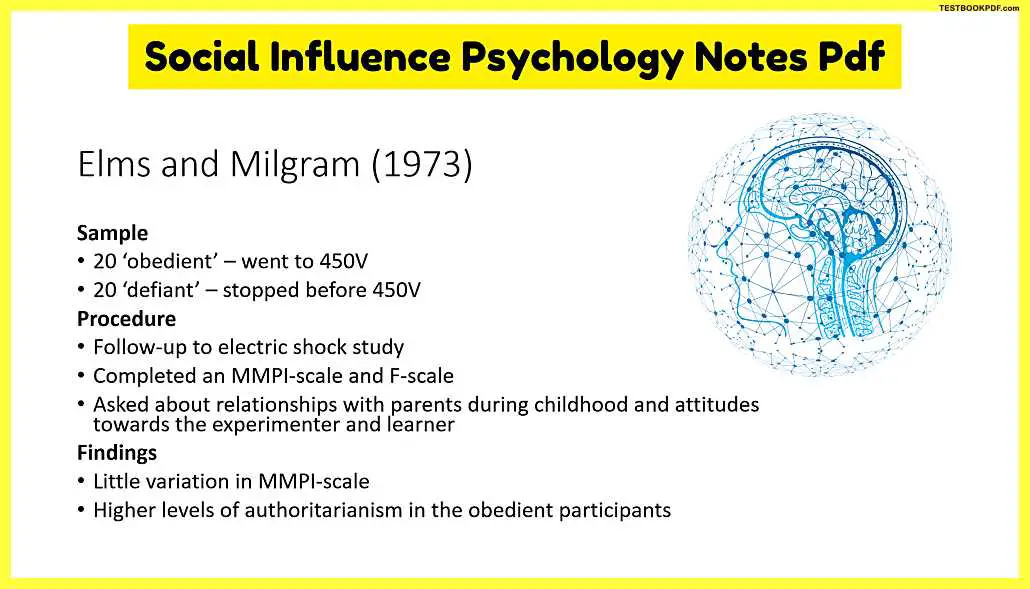
Elms and Milgram the same Milgram that did the previous electric shock study followed up from that study with this one with Elms so the sample was twenty obedient people he went to 20 50 volts and then 20 to define people who stopped before the 450 volts.
In terms of the receiver, they completed the MMPI scale which I believe is just another personality test, and then the F scale, and they were asked about relationships with their parents during childhood as she reports the experimenter and learner within the EC within the study when within the original study sorry and then terms of the findings there were little variation MMPI scale results, however, those who were obedient during the original study had high levels of authoritarianism found in the F scale.
Explanations of resistance to social influence
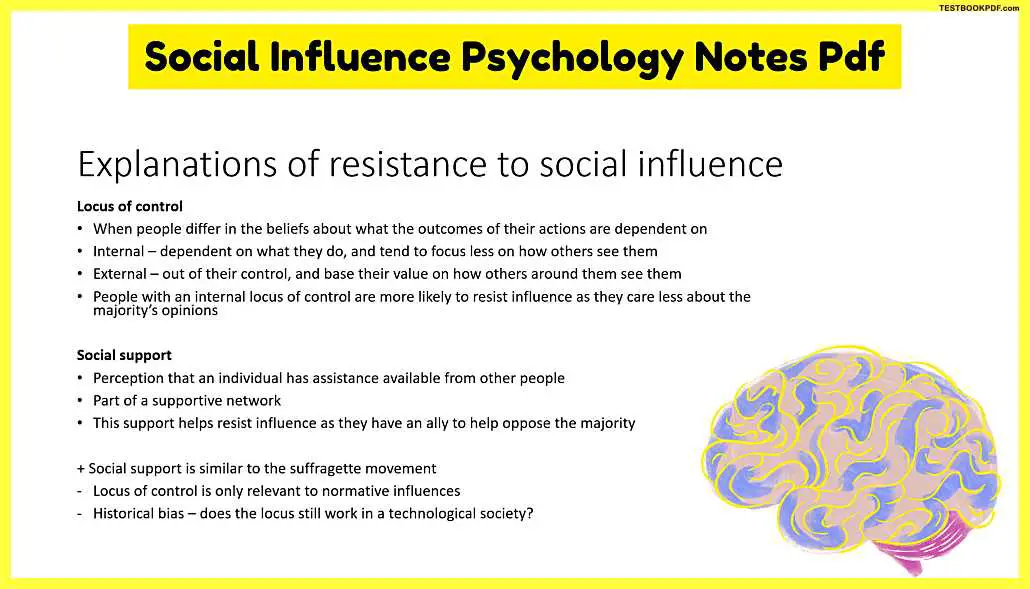
Locus of control – There is the locus of control which is when people differ in their beliefs about what the outcomes of their actions are dependent on so those were the internal locus of control believed that their action that outcomes their actions are dependent on what they do and they tend to focus less on how others see them.
In terms of external acts which control the people see the outcomes are actions as being out of their locus of control and based thereby on how others around them see them this own personally reminds me of the clip from the Big Bang Theory where penny first meets Leonard’s mother and they’re walking up the stairs and Leonard’s mother was Beverly Hofstadter was a questioning penny about why she wanted to be an actress.
So I think you should definitely try and find that clip on YouTube I tend to come across it quite long on Facebook so I don’t know if you may have seen on there I’ll actually just watch the program but people with an internal locus of control I’m more likely to resist influence as obviously, they care less about the majority’s opinions.
Social Support – In terms of social support except this the perception that individual has assisted available from other people and are part of a supportive network and obviously this supportive network will help them resist the influence in society as they believe they have an ally on their side help oppose the majority in case there is a few conflicts take place as important this obviously social support is similar to the suffragette movement in which females supported other females such as like Emily Pankhurst I believe who jumped in front of the pause in front of the Kings horse in which inevitably entered her life but however the locus of control is only relevant to normative influences which you spoke about earlier in the video but also there is a historical bias does the locus of control still have an impact on our behavior in a technological society because I’ve seen now we have all this social media where everyone just puts their opinion out no matter what it is by whether it is the mainstream or not.
Minority Influence
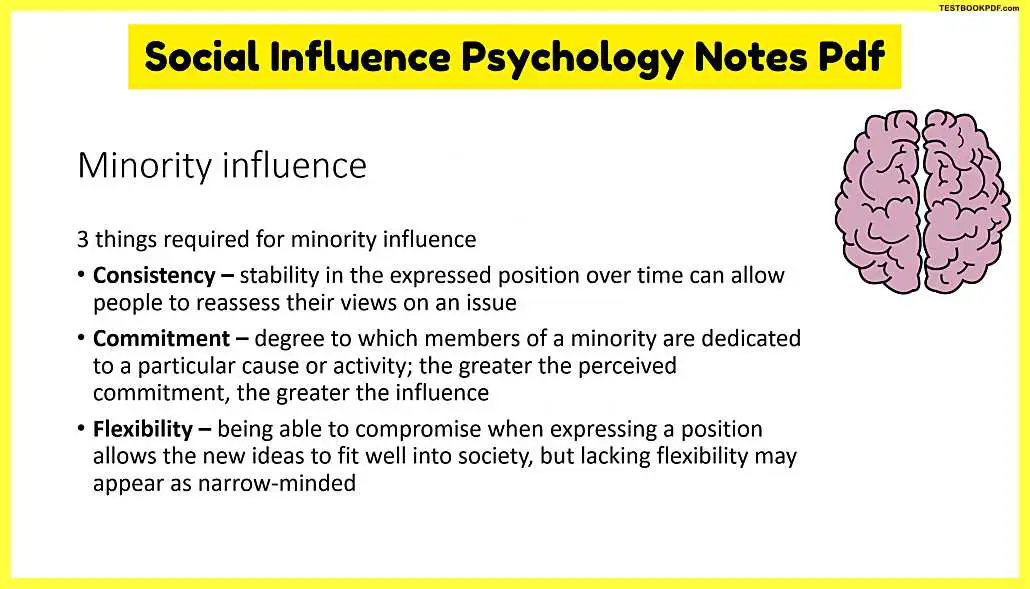
Three things are required for minority influence consistency commitment and flexibility.
Consistency – Consistency is when there’s stability in the express position over time which allows people to reassess their views of an issue.
Commitment – Commitment is the degree to which members of a minority are dedicated to a particular cause or activity and obviously, the greater the perceived commitment the greater the influence because people from the majority population were able to see how important it is to those fighting for their flexibility.
Flexibility – If the group is able to compromise when expressing their position in society and allowing their ideas to fit well into the courage cited we have then obviously the influence be greater But lacking the flexibility may appear as narrow-minded to onlookers but obviously, you want to be careful as well because if you’re too flexible it may appear as inconsistent which is obviously required for minors and not minority influence to take place.
Moscovici et al 1969
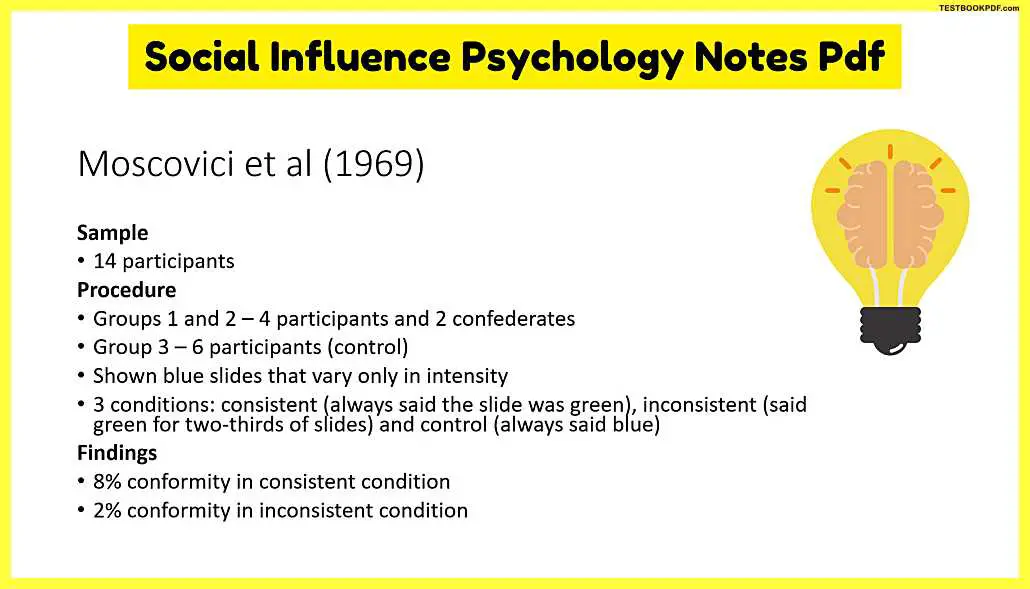
Looking at Moscovici et al 1969 study there was a sample of 14 participants there were three groups entitled so groups one or two had four participants and two Confederates and then group three had six participants which was the control group throughout the study, there was this something that you really need to remember is they were consistently only shown through slides that are varied only in intensity so they did not change color at all it was blue and were just vary between lighter or darker blue and there were three conditions in the study she had a consistent which is when that slides always when the Confederates always said that sliders green and then there was inconsistent which when Green was said for two-thirds of the two-thirds of slides and the control is when the everyone said blue.
So in terms of findings in apes, there was eight percent conformity and consistent condition in the consistent condition but there was only two percent conformity in the inconsistent condition I know it’s all small percentages but it still shows a link between the consistency and the conformity rates.
Social Influence Processes for Minority
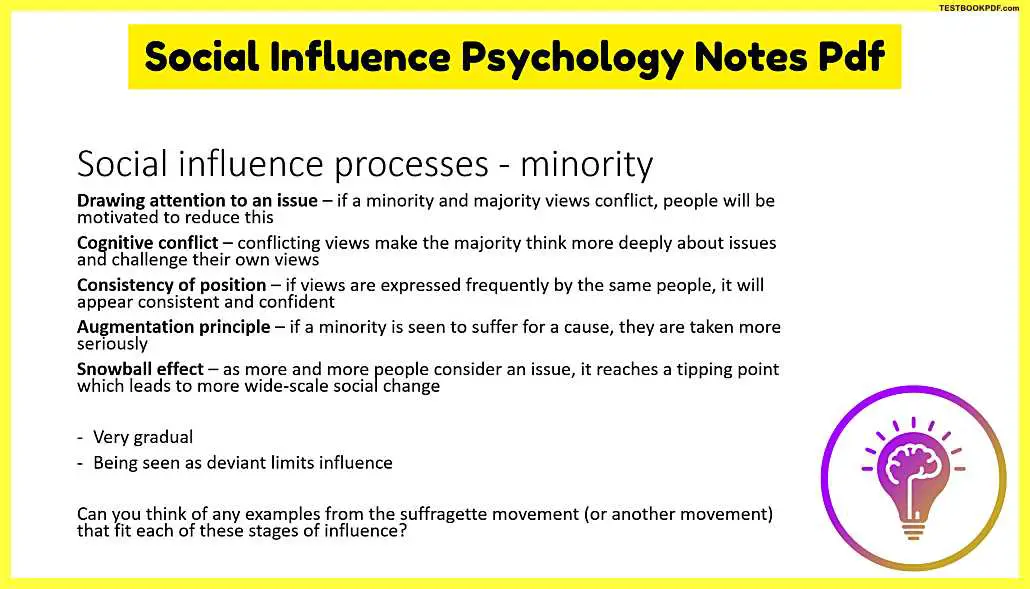
It starts off with drawing attention to the issues obviously the conflicting views people in society will be motivated to reduce this either by accepting the views or by eliminating the minority this will so but in this case, it will be there wanting to accept these new views to reduce the conflict and then I’ll see you’ve got the complex cognitive conflicts which are when the cognitive conflicting views make the majority think more deeply about issues and challenge their own views and consistency of the position.
so again persisting like like we said before if user Express frequently by the same people it will appear consistent and confident and ultimately you’ve got the augmentation principle whereas if a minority has seemed to suffer for a cause they are taken more seriously and then lastly you’ve got the snowball effect in which as more and more people consider an issue at reach the tipping point into wider scale social change and I really really adds ice at the bottom in this page I really want you guys to think a bit more so I want you to think of some examples from these suffragette movements or possibly another movement that you’re more informed about or even if you want to find a new movement that’s all fit these and this they each of these stages of influence.
The Social influence processes of the majority
This is fairly simple say this just involves the social norms intervention which is an attempt to correct misperceptions of normative behavior that appears to change the risky behavior of a target population but obviously this doesn’t always lead to change for example people where people who are informed that they use less energy than the average user actually it increased how much energy they consumed so which had sought which ended up having sort of slightly backward effect on how they behaved and an example of it is this post here it says did you know 96% of us think we should always try to be friendly with students who are different from us which is a fairly basic example but it gets the point across so anyway that is the end of the social influence.
